Abstract
1. A number of centrally acting hypotensive agents and other ligands with high affinity for 5-hydroxytryptamine1A (5-HT1A) recognition sites have been tested on forskolin-stimulated adenylate cyclase activity in calf hippocampus, a functional model for 5-HT1A-receptors. 2. Concentration-dependent inhibition of forskolin-stimulated adenylate cyclase activity was elicited by the reference 5-HT1-receptor agonists (mean EC50 value, nM): 5-HT (22), 5-carboxamidotryptamine (5-CT, 3.2), 8-hydroxy-2-(di-n-propylamino)-tetralin (8-OH-DPAT, 8.6), N,N-dipropyl-5-carboxamidotryptamine (DP-5-CT, 2.3), 1-[2-(4-aminophenyl)ethyl]-4-(3-trifluoromethylphenyl)-piperazine (PAPP or LY 165163, 20), 5-methoxy-3-(1,2,3,6-tetrahydro-4-pyridinyl)-1H indole (RU 24969, 20), buspirone (65) and ipsapirone (56). Emax amounted to 18-20% inhibition for all but the latter two agonists (14%). 3. The following hypotensive agents with high affinity for 5-HT1A sites were potent agonists in this system (mean EC50 value, nM): flesinoxan (24), indorenate (99), erythro-1-(1-[2-(1,4-benzodioxan-2-yl)-2-hydroxyethyl]-4-piperidyl )- 2-benzimidazolinone (R 28935, 2.5), urapidil (390) and 5-methyl-urapidil (3.5). The first two agents were full agonists, whereas the latter three acted as partial agonists with 60-80% efficacy. 4. Metergoline and methysergide behaved as full agonists and cyanopindolol as a partial agonist with low efficacy. Spiroxatrine and 2-(2,6-dimethoxyphenoxyethyl)aminomethyl- 1,4-benzodioxane (WB 4101) which bind to 5-HT1A sites with nanomolar affinity, were agonists and inhibited potently forskolin-stimulated adenylate cyclase in calf hippocampus, showing mean EC50 values of 23 and 15 nM, respectively. Spiroxatrine and WB 4101 yielded 90% and 50% efficacy, respectively. 5. Spiperone and methiothepin (each 1 microM) caused rightward shifts of the concentration-effect curve to 8-OH-DPAT, without loss of the maximal effect, as did the partial agonist cyanopindolol (0.1 microM) and the (-)- and (+)-enantiomers of pindolol (1 microM and 0.1 mM, respectively). 6. There was an excellent correlation (r = 0.90, P = 0.0001) between the pEC50 values (ranging from 6.4 to 8.7) of the 19 agonists tested at adenylate cyclase and their pKD for 5-HT1A recognition sites. Apparent pKB values of antagonists at adenylate cyclase and their pKD values for 5-HT1A binding sites were also significantly correlated. 7. This study further indicates that the 5-HT1A recognition site and the 5-HT receptor mediating inhibition of adenylate cyclase in hippocampus are the same.(ABSTRACT TRUNCATED AT 400 WORDS)
Full text
PDF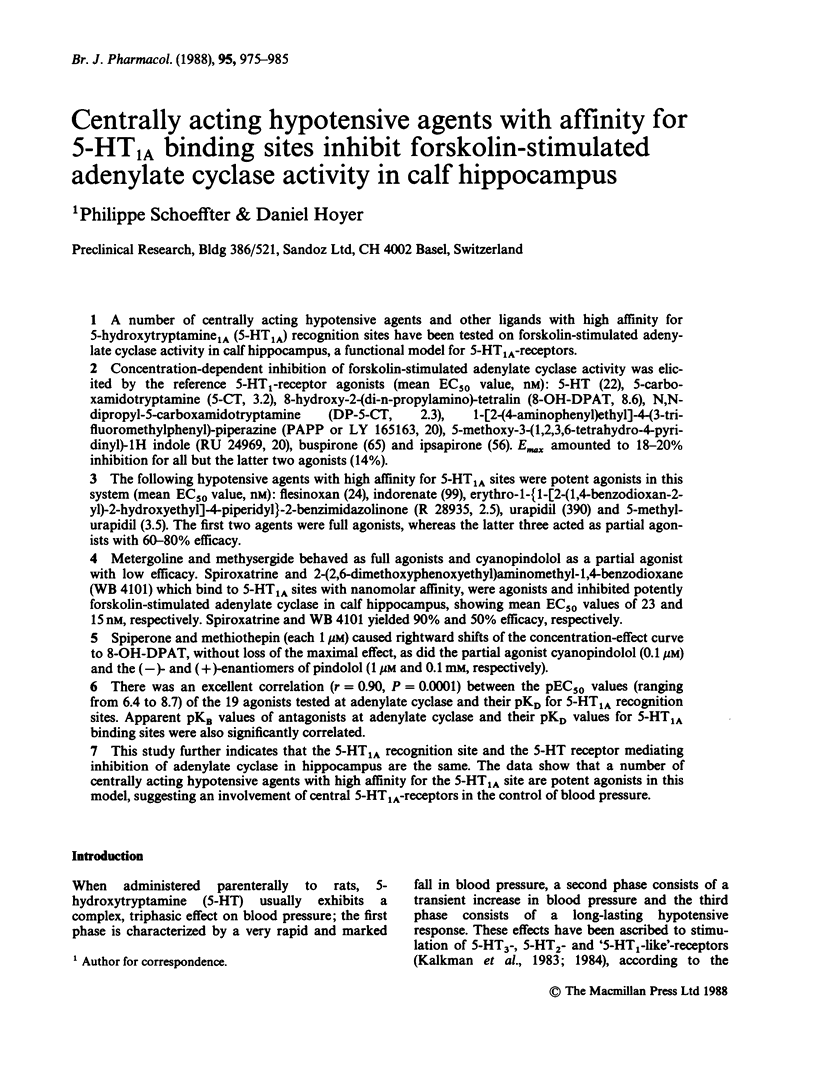


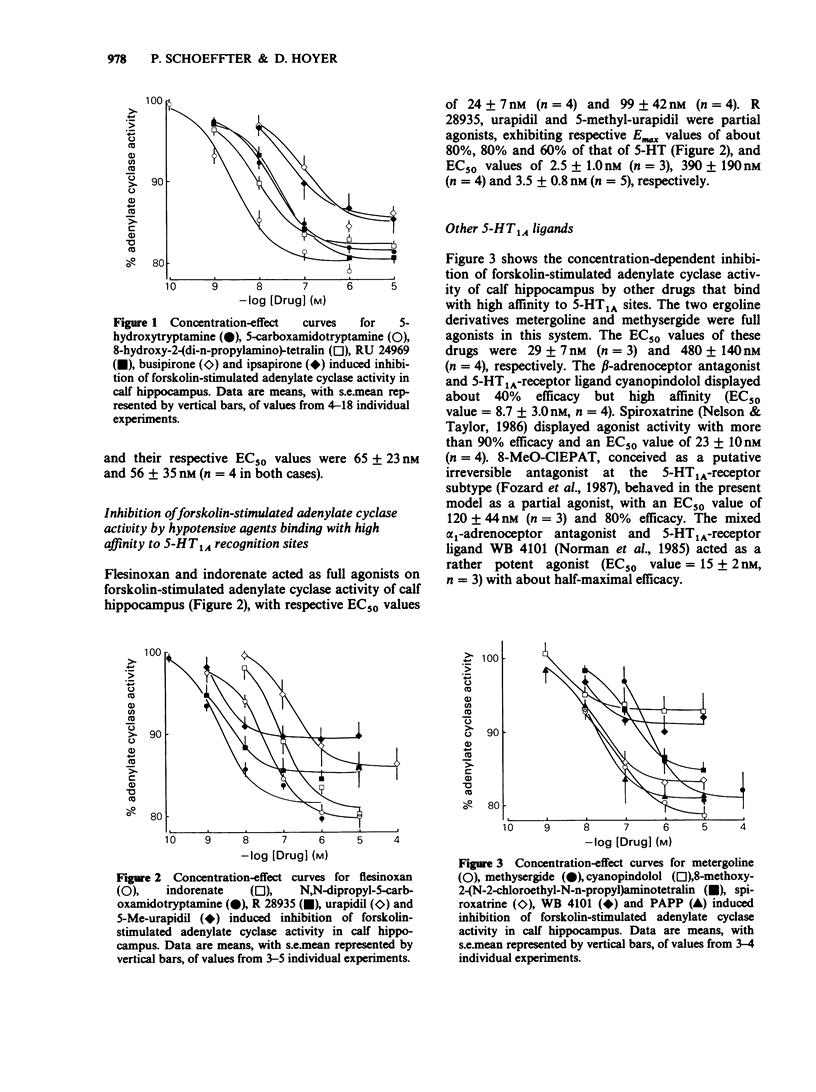



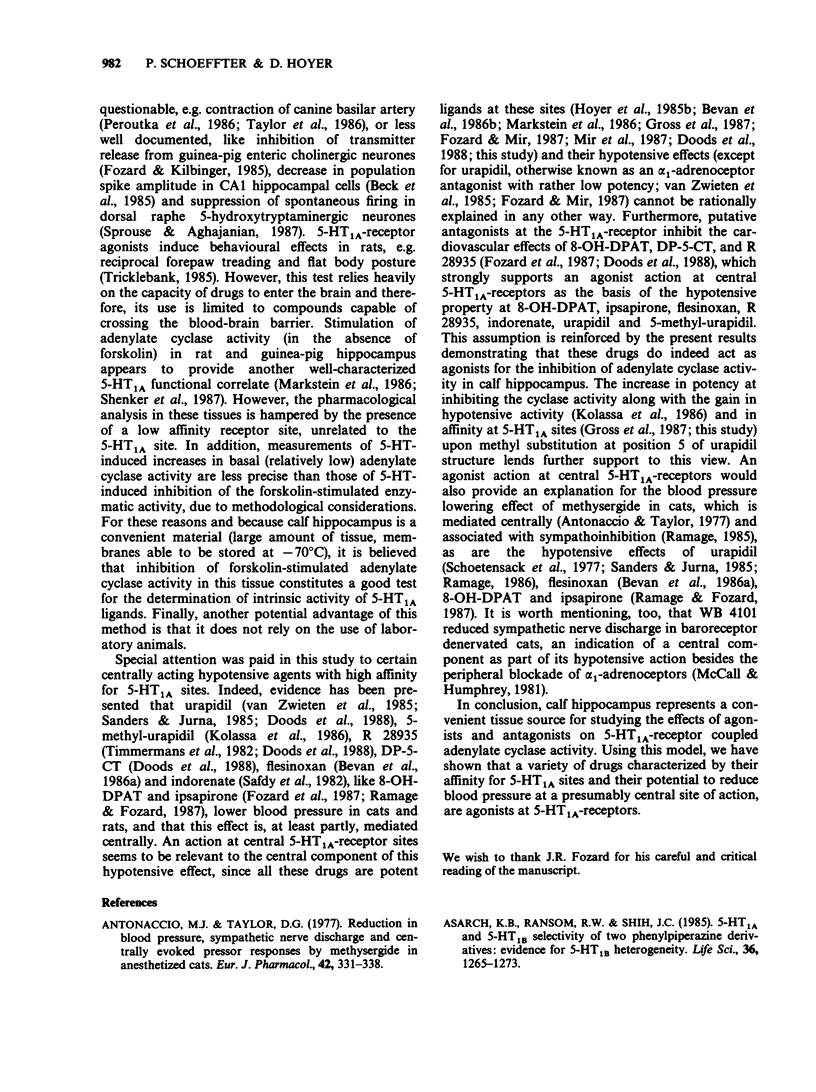
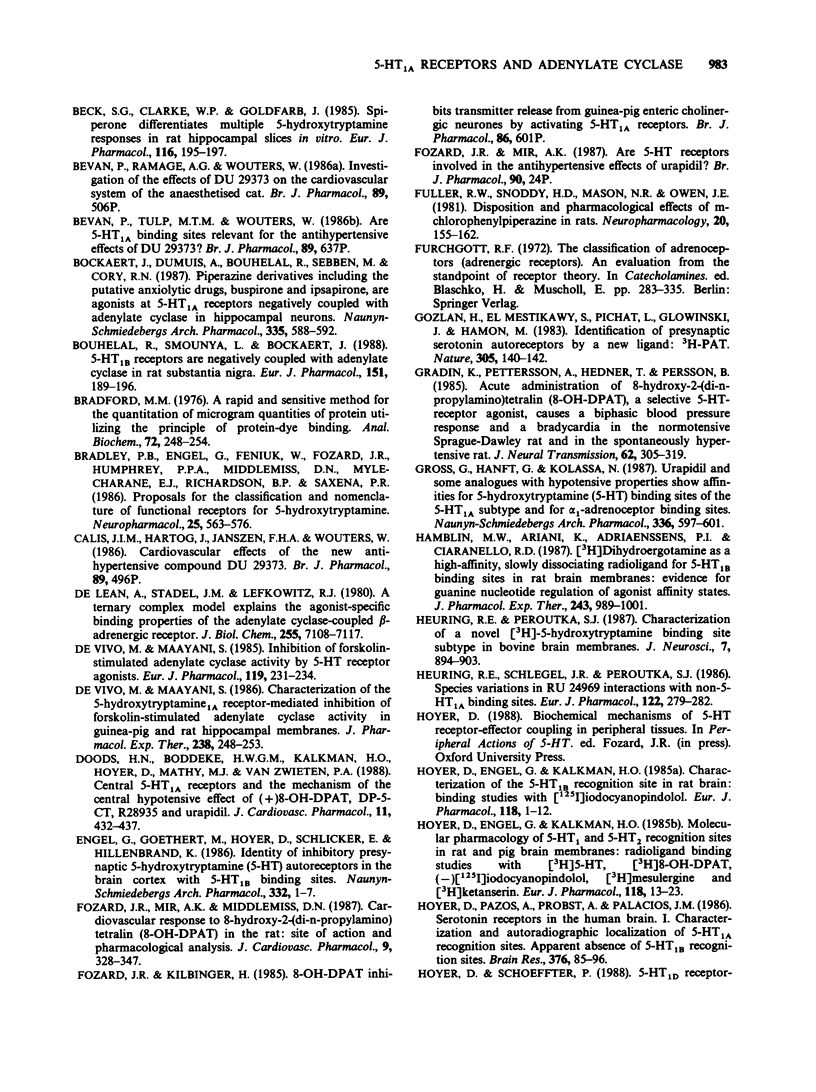

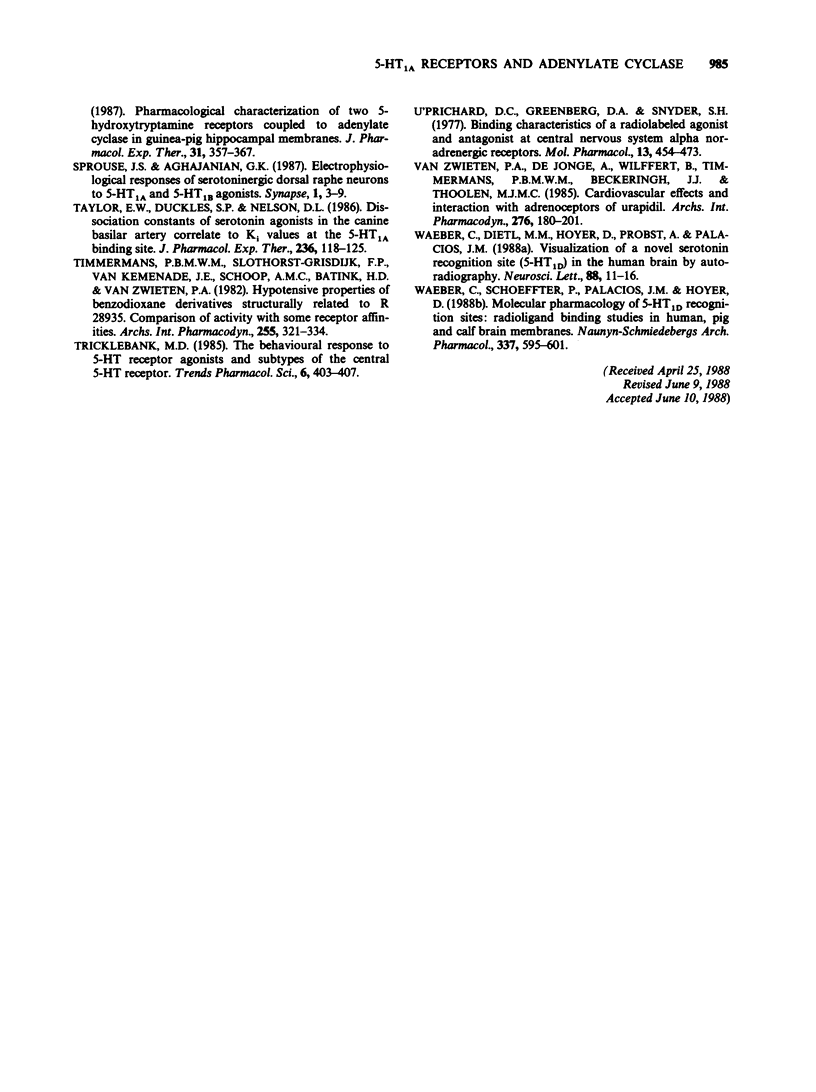
Selected References
These references are in PubMed. This may not be the complete list of references from this article.
- Antonaccio M. J., Taylor D. G. Reduction in blood pressure, sympathetic nerve discharge and centrally evoked pressor responses by methysergide in anesthetized cats. Eur J Pharmacol. 1977 Apr 21;42(4):331–338. doi: 10.1016/0014-2999(77)90166-2. [DOI] [PubMed] [Google Scholar]
- Asarch K. B., Ransom R. W., Shih J. C. 5-HT-1a and 5-HT-1b selectivity of two phenylpiperazine derivatives: evidence for 5-HT-1b heterogeneity. Life Sci. 1985 Apr 1;36(13):1265–1273. doi: 10.1016/0024-3205(85)90271-1. [DOI] [PubMed] [Google Scholar]
- Beck S. G., Clarke W. P., Goldfarb J. Spiperone differentiates multiple 5-hydroxytryptamine responses in rat hippocampal slices in vitro. Eur J Pharmacol. 1985 Oct 8;116(1-2):195–197. doi: 10.1016/0014-2999(85)90206-7. [DOI] [PubMed] [Google Scholar]
- Black J. W., Shankley N. P. Pharmacological analysis of muscarinic receptors coupled to oxyntic cell secretion in the mouse stomach. Br J Pharmacol. 1985 Nov;86(3):601–607. doi: 10.1111/j.1476-5381.1985.tb08936.x. [DOI] [PMC free article] [PubMed] [Google Scholar]
- Bockaert J., Dumuis A., Bouhelal R., Sebben M., Cory R. N. Piperazine derivatives including the putative anxiolytic drugs, buspirone and ipsapirone, are agonists at 5-HT1A receptors negatively coupled with adenylate cyclase in hippocampal neurons. Naunyn Schmiedebergs Arch Pharmacol. 1987 May;335(5):588–592. doi: 10.1007/BF00169129. [DOI] [PubMed] [Google Scholar]
- Bouhelal R., Smounya L., Bockaert J. 5-HT1B receptors are negatively coupled with adenylate cyclase in rat substantia nigra. Eur J Pharmacol. 1988 Jul 7;151(2):189–196. doi: 10.1016/0014-2999(88)90799-6. [DOI] [PubMed] [Google Scholar]
- Bradford M. M. A rapid and sensitive method for the quantitation of microgram quantities of protein utilizing the principle of protein-dye binding. Anal Biochem. 1976 May 7;72:248–254. doi: 10.1016/0003-2697(76)90527-3. [DOI] [PubMed] [Google Scholar]
- Bradley P. B., Engel G., Feniuk W., Fozard J. R., Humphrey P. P., Middlemiss D. N., Mylecharane E. J., Richardson B. P., Saxena P. R. Proposals for the classification and nomenclature of functional receptors for 5-hydroxytryptamine. Neuropharmacology. 1986 Jun;25(6):563–576. doi: 10.1016/0028-3908(86)90207-8. [DOI] [PubMed] [Google Scholar]
- De Lean A., Stadel J. M., Lefkowitz R. J. A ternary complex model explains the agonist-specific binding properties of the adenylate cyclase-coupled beta-adrenergic receptor. J Biol Chem. 1980 Aug 10;255(15):7108–7117. [PubMed] [Google Scholar]
- De Vivo M., Maayani S. Characterization of the 5-hydroxytryptamine1a receptor-mediated inhibition of forskolin-stimulated adenylate cyclase activity in guinea pig and rat hippocampal membranes. J Pharmacol Exp Ther. 1986 Jul;238(1):248–253. [PubMed] [Google Scholar]
- Devivo M., Maayani S. Inhibition of forskolin-stimulated adenylate cyclase activity by 5-HT receptor agonists. Eur J Pharmacol. 1985 Dec 17;119(3):231–234. doi: 10.1016/0014-2999(85)90300-0. [DOI] [PubMed] [Google Scholar]
- Doods H. N., Boddeke H. W., Kalkman H. O., Hoyer D., Mathy M. J., van Zwieten P. A. Central 5-HT1A receptors and the mechanism of the central hypotensive effect of (+)8-OH-DPAT, DP-5-CT, R28935, and urapidil. J Cardiovasc Pharmacol. 1988 Apr;11(4):432–437. doi: 10.1097/00005344-198804000-00008. [DOI] [PubMed] [Google Scholar]
- Engel G., Göthert M., Hoyer D., Schlicker E., Hillenbrand K. Identity of inhibitory presynaptic 5-hydroxytryptamine (5-HT) autoreceptors in the rat brain cortex with 5-HT1B binding sites. Naunyn Schmiedebergs Arch Pharmacol. 1986 Jan;332(1):1–7. doi: 10.1007/BF00633189. [DOI] [PubMed] [Google Scholar]
- Fozard J. R., Mir A. K., Middlemiss D. N. Cardiovascular response to 8-hydroxy-2-(di-n-propylamino) tetralin (8-OH-DPAT) in the rat: site of action and pharmacological analysis. J Cardiovasc Pharmacol. 1987 Mar;9(3):328–347. doi: 10.1097/00005344-198703000-00010. [DOI] [PubMed] [Google Scholar]
- Fuller R. W., Snoddy H. D., Mason N. R., Owen J. E. Disposition and pharmacological effects of m-Chlorophenylpiperazine in rats. Neuropharmacology. 1981 Feb;20(2):155–162. doi: 10.1016/0028-3908(81)90198-2. [DOI] [PubMed] [Google Scholar]
- Gozlan H., El Mestikawy S., Pichat L., Glowinski J., Hamon M. Identification of presynaptic serotonin autoreceptors using a new ligand: 3H-PAT. Nature. 1983 Sep 8;305(5930):140–142. doi: 10.1038/305140a0. [DOI] [PubMed] [Google Scholar]
- Gradin K., Pettersson A., Hedner T., Persson B. Acute administration of 8-hydroxy-2-(di-n-propylamino)tetralin (8-OH-DPAT), a selective 5-HT-receptor agonist, causes a biphasic blood pressure response and a bradycardia in the normotensive Sprague-Dawley rat and in the spontaneously hypertensive rat. J Neural Transm. 1985;62(3-4):305–319. doi: 10.1007/BF01252244. [DOI] [PubMed] [Google Scholar]
- Gross G., Hanft G., Kolassa N. Urapidil and some analogues with hypotensive properties show high affinities for 5-hydroxytryptamine (5-HT) binding sites of the 5-HT1A subtype and for alpha 1-adrenoceptor binding sites. Naunyn Schmiedebergs Arch Pharmacol. 1987 Dec;336(6):597–601. doi: 10.1007/BF00165749. [DOI] [PubMed] [Google Scholar]
- Hamblin M. W., Ariani K., Adriaenssens P. I., Ciaranello R. D. [3H]dihydroergotamine as a high-affinity, slowly dissociating radioligand for 5-HT1B binding sites in rat brain membranes: evidence for guanine nucleotide regulation of agonist affinity states. J Pharmacol Exp Ther. 1987 Dec;243(3):989–1001. [PubMed] [Google Scholar]
- Heuring R. E., Peroutka S. J. Characterization of a novel 3H-5-hydroxytryptamine binding site subtype in bovine brain membranes. J Neurosci. 1987 Mar;7(3):894–903. doi: 10.1523/JNEUROSCI.07-03-00894.1987. [DOI] [PMC free article] [PubMed] [Google Scholar]
- Heuring R. E., Schlegel J. R., Peroutka S. J. Species variations in RU 24969 interactions with non-5-HT1A binding sites. Eur J Pharmacol. 1986 Mar 18;122(2):279–282. doi: 10.1016/0014-2999(86)90114-7. [DOI] [PubMed] [Google Scholar]
- Hoyer D., Engel G., Kalkman H. O. Characterization of the 5-HT1B recognition site in rat brain: binding studies with (-)[125I]iodocyanopindolol. Eur J Pharmacol. 1985 Nov 26;118(1-2):1–12. doi: 10.1016/0014-2999(85)90657-0. [DOI] [PubMed] [Google Scholar]
- Hoyer D., Engel G., Kalkman H. O. Molecular pharmacology of 5-HT1 and 5-HT2 recognition sites in rat and pig brain membranes: radioligand binding studies with [3H]5-HT, [3H]8-OH-DPAT, (-)[125I]iodocyanopindolol, [3H]mesulergine and [3H]ketanserin. Eur J Pharmacol. 1985 Nov 26;118(1-2):13–23. doi: 10.1016/0014-2999(85)90658-2. [DOI] [PubMed] [Google Scholar]
- Hoyer D., Pazos A., Probst A., Palacios J. M. Serotonin receptors in the human brain. I. Characterization and autoradiographic localization of 5-HT1A recognition sites. Apparent absence of 5-HT1B recognition sites. Brain Res. 1986 Jun 18;376(1):85–96. doi: 10.1016/0006-8993(86)90902-9. [DOI] [PubMed] [Google Scholar]
- Hoyer D., Schoeffter P. 5-HT1D receptor-mediated inhibition of forskolin-stimulated adenylate cyclase activity in calf substantia nigra. Eur J Pharmacol. 1988 Feb 16;147(1):145–147. doi: 10.1016/0014-2999(88)90645-0. [DOI] [PubMed] [Google Scholar]
- Hutson P. H., Donohoe T. P., Curzon G. Neurochemical and behavioural evidence for an agonist action of 1-[2-(4-aminophenyl)ethyl]-4-(3-trifluoromethylphenyl)piperazine (LY 165163) at central 5-HT receptors. Eur J Pharmacol. 1987 Jun 19;138(2):215–223. doi: 10.1016/0014-2999(87)90435-3. [DOI] [PubMed] [Google Scholar]
- Kalkman H. O., Boddeke H. W., Doods H. N., Timmermans P. B., Van Zwieten P. A. Hypotensive activity of serotonin receptor agonists in rats is related to their affinity for 5-HT1 receptors. Eur J Pharmacol. 1983 Jul 15;91(1):155–156. doi: 10.1016/0014-2999(83)90382-5. [DOI] [PubMed] [Google Scholar]
- Kenakin T. P. The classification of drugs and drug receptors in isolated tissues. Pharmacol Rev. 1984 Sep;36(3):165–222. [PubMed] [Google Scholar]
- Markstein R., Hoyer D., Engel G. 5-HT1A-receptors mediate stimulation of adenylate cyclase in rat hippocampus. Naunyn Schmiedebergs Arch Pharmacol. 1986 Aug;333(4):335–341. doi: 10.1007/BF00500006. [DOI] [PubMed] [Google Scholar]
- Martin G. E., Lis E. V., Jr Hypotensive action of 8-hydroxy-2-(di-N-propylamino)tetralin (8-OH-DPAT) in spontaneously hypertensive rats. Arch Int Pharmacodyn Ther. 1985 Feb;273(2):251–261. [PubMed] [Google Scholar]
- McCall R. B., Humphrey S. J. Evidence for a central depressor action of postsynaptic alpha 1-adrenergic receptor antagonists. J Auton Nerv Syst. 1981 Feb;3(1):9–23. doi: 10.1016/0165-1838(81)90026-6. [DOI] [PubMed] [Google Scholar]
- Middlemiss D. N., Fozard J. R. 8-Hydroxy-2-(di-n-propylamino)-tetralin discriminates between subtypes of the 5-HT1 recognition site. Eur J Pharmacol. 1983 May 20;90(1):151–153. doi: 10.1016/0014-2999(83)90230-3. [DOI] [PubMed] [Google Scholar]
- Nelson D. L., Monroe P. J., Lambert G., Yamamura H. I. [3H]spiroxatrine labels a serotonin1A-like site in the rat hippocampus. Life Sci. 1987 Sep 28;41(13):1567–1576. doi: 10.1016/0024-3205(87)90723-5. [DOI] [PubMed] [Google Scholar]
- Nelson D. L., Taylor E. W. Spiroxatrine: a selective serotonin1A receptor antagonist. Eur J Pharmacol. 1986 May 13;124(1-2):207–208. doi: 10.1016/0014-2999(86)90147-0. [DOI] [PubMed] [Google Scholar]
- Norman A. B., Battaglia G., Creese I. [3H]WB4101 labels the 5-HT1A serotonin receptor subtype in rat brain. Guanine nucleotide and divalent cation sensitivity. Mol Pharmacol. 1985 Dec;28(6):487–494. [PubMed] [Google Scholar]
- Pazos A., Hoyer D., Palacios J. M. The binding of serotonergic ligands to the porcine choroid plexus: characterization of a new type of serotonin recognition site. Eur J Pharmacol. 1984 Nov 27;106(3):539–546. doi: 10.1016/0014-2999(84)90057-8. [DOI] [PubMed] [Google Scholar]
- Pazos A., Probst A., Palacios J. M. Serotonin receptors in the human brain--III. Autoradiographic mapping of serotonin-1 receptors. Neuroscience. 1987 Apr;21(1):97–122. doi: 10.1016/0306-4522(87)90326-5. [DOI] [PubMed] [Google Scholar]
- Pedigo N. W., Yamamura H. I., Nelson D. L. Discrimination of multiple [3H]5-hydroxytryptamine binding sites by the neuroleptic spiperone in rat brain. J Neurochem. 1981 Jan;36(1):220–226. doi: 10.1111/j.1471-4159.1981.tb02397.x. [DOI] [PubMed] [Google Scholar]
- Peroutka S. J., Huang S., Allen G. S. Canine basilar artery contractions mediated by 5-hydroxytryptamine1A receptors. J Pharmacol Exp Ther. 1986 Jun;237(3):901–906. [PubMed] [Google Scholar]
- Peroutka S. J. Selective interaction of novel anxiolytics with 5-hydroxytryptamine1A receptors. Biol Psychiatry. 1985 Sep;20(9):971–979. doi: 10.1016/0006-3223(85)90194-5. [DOI] [PubMed] [Google Scholar]
- Peroutka S. J., Snyder S. H. Multiple serotonin receptors: differential binding of [3H]5-hydroxytryptamine, [3H]lysergic acid diethylamide and [3H]spiroperidol. Mol Pharmacol. 1979 Nov;16(3):687–699. [PubMed] [Google Scholar]
- Ram J. L., Kreiman M. A., Gole D. LY165163 and 8-OH-DPAT have agonist effects on a serotonin responsive muscle of Aplysia. Eur J Pharmacol. 1987 Jul 9;139(2):247–250. doi: 10.1016/0014-2999(87)90259-7. [DOI] [PubMed] [Google Scholar]
- Ramage A. G. A comparison of the effects of doxazosin and alfuzosin with those of urapidil on preganglionic sympathetic nerve activity in anaesthetised cats. Eur J Pharmacol. 1986 Oct 7;129(3):307–314. doi: 10.1016/0014-2999(86)90440-1. [DOI] [PubMed] [Google Scholar]
- Ramage A. G., Fozard J. R. Evidence that the putative 5-HT1A receptor agonists, 8-OH-DPAT and ipsapirone, have a central hypotensive action that differs from that of clonidine in anaesthetised cats. Eur J Pharmacol. 1987 Jun 19;138(2):179–191. doi: 10.1016/0014-2999(87)90431-6. [DOI] [PubMed] [Google Scholar]
- Ramage A. G. The effects of ketanserin, methysergide and LY 53857 on sympathetic nerve activity. Eur J Pharmacol. 1985 Jul 31;113(3):295–303. doi: 10.1016/0014-2999(85)90076-7. [DOI] [PubMed] [Google Scholar]
- Safdy M. E., Kurchacova E., Schut R. N., Vidrio H., Hong E. Tryptophan analogues. 1. Synthesis and antihypertensive activity of positional isomers. J Med Chem. 1982 Jun;25(6):723–730. doi: 10.1021/jm00348a022. [DOI] [PubMed] [Google Scholar]
- Salomon Y., Londos C., Rodbell M. A highly sensitive adenylate cyclase assay. Anal Biochem. 1974 Apr;58(2):541–548. doi: 10.1016/0003-2697(74)90222-x. [DOI] [PubMed] [Google Scholar]
- Sanders K. H., Jurna I. Effects of urapidil, clonidine, prazosin and propranolol on autonomic nerve activity, blood pressure and heart rate in anaesthetized rats and cats. Eur J Pharmacol. 1985 Apr 2;110(2):181–190. doi: 10.1016/0014-2999(85)90210-9. [DOI] [PubMed] [Google Scholar]
- Schoeffter P., Waeber C., Palacios J. M., Hoyer D. The 5-hydroxytryptamine 5-HT1D receptor subtype is negatively coupled to adenylate cyclase in calf substantia nigra. Naunyn Schmiedebergs Arch Pharmacol. 1988 Jun;337(6):602–608. doi: 10.1007/BF00175784. [DOI] [PubMed] [Google Scholar]
- Schoetensack W., Bischler P., Dittmann E. C., Steinijans V. Tierexperimentelle Untersuchungen über den Einfluss des Antihypertensivums Urapidil auf den Kreislauf und die Kreislaufregulation. Arzneimittelforschung. 1977;27(10):1908–1919. [PubMed] [Google Scholar]
- Shenker A., Maayani S., Weinstein H., Green J. P. Pharmacological characterization of two 5-hydroxytryptamine receptors coupled to adenylate cyclase in guinea pig hippocampal membranes. Mol Pharmacol. 1987 Apr;31(4):357–367. [PubMed] [Google Scholar]
- Shenker A., Maayani S., Weinstein H., Green J. P. Two 5-HT receptors linked to adenylate cyclase in guinea pig hippocampus are discriminated by 5-carboxamidotryptamine and spiperone. Eur J Pharmacol. 1985 Mar 12;109(3):427–429. doi: 10.1016/0014-2999(85)90408-x. [DOI] [PubMed] [Google Scholar]
- Sprouse J. S., Aghajanian G. K. Electrophysiological responses of serotoninergic dorsal raphe neurons to 5-HT1A and 5-HT1B agonists. Synapse. 1987;1(1):3–9. doi: 10.1002/syn.890010103. [DOI] [PubMed] [Google Scholar]
- Taylor E. W., Duckles S. P., Nelson D. L. Dissociation constants of serotonin agonists in the canine basilar artery correlate to Ki values at the 5-HT1A binding site. J Pharmacol Exp Ther. 1986 Jan;236(1):118–125. [PubMed] [Google Scholar]
- Timmermans P. B., Slothorst-Grisdijk F. P., van Kemenade J. E., Schoop A. M., Batink H. D., van Zwieten P. A. Hypotensive properties of benzodioxane derivatives structurally related to R 28935. Comparison of activity with some receptor affinities. Arch Int Pharmacodyn Ther. 1982 Feb;255(2):321–334. [PubMed] [Google Scholar]
- U'Prichard D. C., Greenberg D. A., Snyder S. H. Binding characteristics of a radiolabeled agonist and antagonist at central nervous system alpha noradrenergic receptors. Mol Pharmacol. 1977 May;13(3):454–473. [PubMed] [Google Scholar]
- Waeber C., Dietl M. M., Hoyer D., Probst A., Palacios J. M. Visualization of a novel serotonin recognition site (5-HT1D) in the human brain by autoradiography. Neurosci Lett. 1988 May 16;88(1):11–16. doi: 10.1016/0304-3940(88)90307-2. [DOI] [PubMed] [Google Scholar]
- Waeber C., Schoeffter P., Palacios J. M., Hoyer D. Molecular pharmacology of 5-HT1D recognition sites: radioligand binding studies in human, pig and calf brain membranes. Naunyn Schmiedebergs Arch Pharmacol. 1988 Jun;337(6):595–601. doi: 10.1007/BF00175783. [DOI] [PubMed] [Google Scholar]
- van Zwieten P. A., de Jonge A., Wilffert B., Timmermans P. B., Beckeringh J. J., Thoolen M. J. Cardiovascular effects and interaction with adrenoceptors of urapidil. Arch Int Pharmacodyn Ther. 1985 Aug;276(2):180–201. [PubMed] [Google Scholar]


